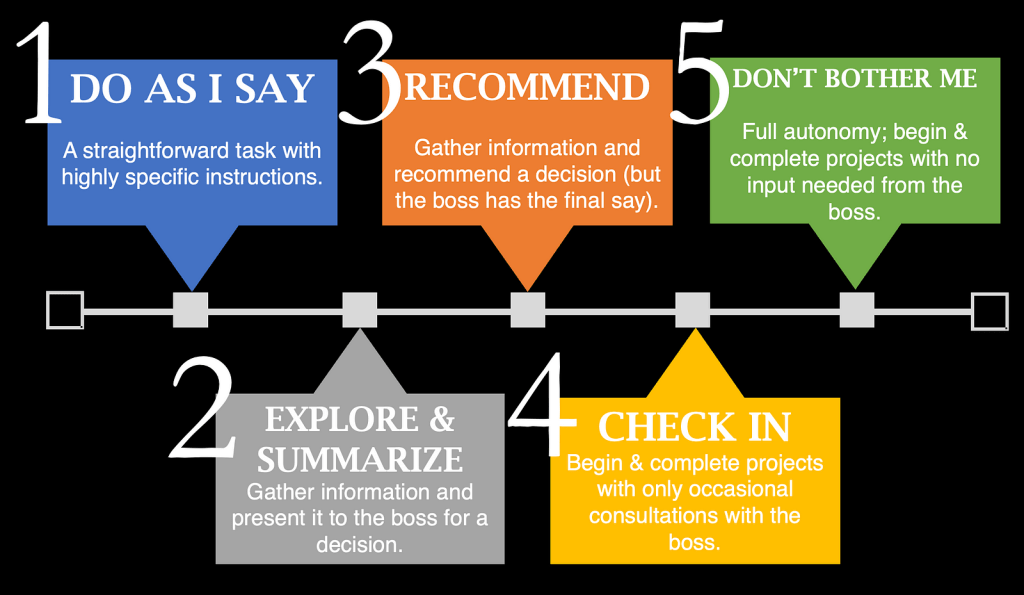Learn to delegate intentionally and effectively to make the process easy for both you and your employees
This post was first published on my Medium blog—follow me there for the most up-to-date entries!

Delegation is one of the surest ways to grow your business. But as Michael Gerber tells us in his E-Myth books, business owners often end up abdicating rather than delegating. That’s a lethal mistake. A way to avoid that is to know when and to whom a task can or should be delegated. And to know that, you should know the levels of delegation.
There are five, six, or seven levels of delegation, depending on which author or expert you ask — I will be using a five-level system in this post. It’s not how many levels you have that counts, or even what they are. It’s how well you can use them. It’s about knowing what level of delegation to use, when, and with whom.

1. Do as I say
This means, do it exactly as directed; do not deviate, interpret, or alter the assignment in any way.
Who you give it to: This works well with a straightforward task and a junior employee or contractor who has the skills to carry it out. For example, any task for which there is a clearly written corporate procedure could be assigned to just about anyone who has acquired enough competencies to be hired for the job in the first place.
What you give them: Explicit directions. You must be extremely clear about what you expect them to do and how you want them to do it. Sometimes this level of delegation can feel like more work than just doing it yourself, but if it’s a task that occurs multiple times, some extra work on the front end will pay off later.
What you get back: A completed task to your specifications. This level of delegation is about execution alone.
2. Explore and summarize
In this situation, you’re assigning something that’s bigger than a straightforward task. You’re assigning your employee to gather enough information to allow the boss (you) to make a decision.
Who you give it to: Here, you need a person who understands the definition, facts, and fundamental concepts of what will eventually result in the boss’s decision.
What you give them: Let’s say I want to decide which customer relationship management (CRM) software the business should use. Before I make the assignment, I either need to specify or be sure that the assignee recognizes and can find:
- all or at least several different big names: Hubspot, Keap (InfusionSoft), ClickFunnels, and more.
- what criteria to look for, other than price.
And summarize that information in some meaningful way.
The person exploring the information isn’t likely to be a content expert. That’s okay. The skill needed here is the ability to find, recognize, and use the best information.
What you get back: A presentation of the facts that will help you make a decision. In this level of delegation, you are the one making all the decisions, but your employee is gathering the information.
I’ve used “decision,” and specifically a purchasing decision, as an example. But it’s fair to say that this level is almost always about a problem to solve; one way to solve a problem is to purchase a solution. Other problems to solve might be customer service issues, interpersonal or interdepartmental communication interruptions that occur with working from home, how to meet new government compliance mandates, and more.
This level of delegation is about planning: understanding the assignment, executing it, and presenting the findings.
3. Recommend
Here, you’re asking the assignee to do more than just snoop around and make some comparisons. Rather, you’re asking for some level of analysis of the information that was found.
Who you give it to: The same sort of employee you gave #2 to, but perhaps more knowledgeable or seasoned, or someone whose judgment you have reason to trust at least as much as your own. I would be likely to assign this to someone who has been in my employ for a while; someone who knows my quirks.
What you give them: Unless the assignee has a reasonable understanding of CRM software (to use my previous example), the boss needs to articulate a substantial description of what the existing problem is; the employee needs to know how to solve it.
Words to use might include, “[assignment] needs to be done by [date/time]. Please find credible information, analyze the pros and cons, and tell me what you think should be done.”
In this situation, the assignee needs several skills, including the ability to differentiate between credible information and mere advertising. The assignee also needs to document some strong unbiased reasons for the recommendation.
What you get back: A recommendation that you can consider and make your final decision.
This level of delegation is about planning how to go about the task, executing it, and analyzing and presenting all the data in a meaningful and succinct way.
4. Check in
Believe me, I can delegate right and left! I love this one! But I do need to be sure that it doesn’t come to bite me in the butt.
Who to give it to: An employee you trust enough to consider an expert. In this situation, you’re giving the employee a wide berth. The assigned person must make initial judgements on how to start and follow through with the task — they are setting the task as well as accomplishing it.
What to give them: Here, depending on how long you have been working with this employee, you might need to give some specific parameters; for example, what’s the budget for this project, or some of your pet peeves.
Words to use could be, “[assignment] needs to be planned and executed by [date/time]. Plan and execute this by using your best skills and judgement. Let me know when you’re finished.”
What you get back: A completed task, or many, over which you have had to expend very little of your own energy.
In this level of delegation, you’re asking the assignee to plan and execute independently. You have given up all control.
5. Don’t bother me
I love this one even more, but I don’t use it much except with very seasoned employees.
Who to give it to: In this situation, the assignee has a stellar track record for gathering information, spotting issues along the way, problem-solving effectively, communicating clearly and respectfully to teammates, and following through in a timely manner.
What to give them: Words to use could be, “[assignment] needs to be done and executed by [date/time]. Make it happen. No need to report back, I trust you completely.”
What you get back: A business that grows without need for your interference!
This level of delegation is the ultimate in trust. It involves risk, but can also give incredible results. Run your employee through the earlier levels of delegation first, and if you can get here with them, you can take entire aspects of your business off your own plate.
Delegate intentionally
You know from reading about it, from personal experience, and just from a gut feeling: your business will never reach its full potential if you do everything yourself. At some point, you must learn to delegate. This might not be everything you need to know about delegation, but it’s a good start. It boils down to:
- the assignee’s skills, past experience, and role in the assignment,
- your ability to know how much control you want to retain or give up, and
- clearly communicating that to another person.

What’s your most difficult part of delegating an assignment?
This post was first published on my Medium blog—follow me there for the most up-to-date entries!
I am a participant in the Amazon Services LLC Associates Program, an affiliate advertising program designed to provide a means for us to earn fees by linking to Amazon.com and affiliated sites.
